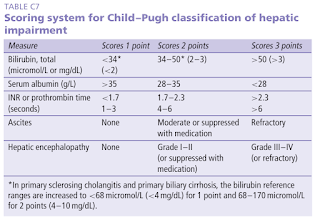Child-Pugh Score
Introduction
Determining the degree of hepatic impairment is much trickier than with renal function. Several methods exist, but the most commonly used is the Child-Pugh classification, which has been developed as a prognostic tool in chronic liver disease.
Scoring System
For the Child-Pugh classification, 5 clinical measures of liver disease are given scores of 1, 2 or 3 points in increasing severity. The scores for each parameter are added together and the degree of hepatic impairment is categorised as Child-Pugh class A-C as follows:
- Class A: 5-6 points (well-compensated disease)
- Class B: 7-9 points (significant functional compromise)
- Class C: 10-15 points (decompensated disease)
Determining Dosage Adjustment
When liver function is impaired, drugs metabolised or excreted by the liver may accumulate in the body if liver function is impaired. Consequently, doses should be adjusted or the drug avoided altogether if necessary.

Comments
Post a Comment